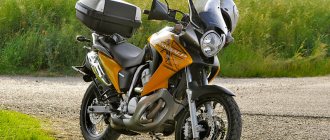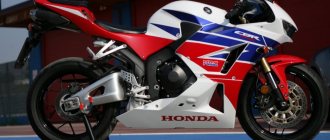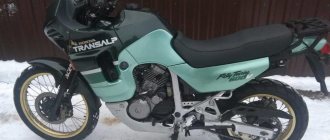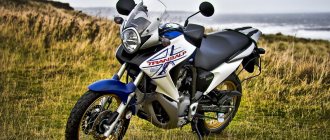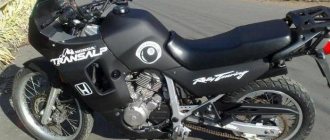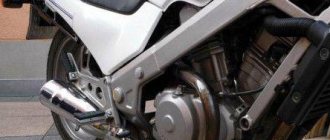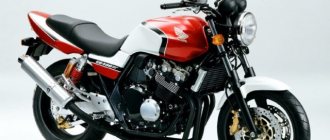First generation (1987–2000) Honda XL 600 V Transalp
The first generation, represented by the Honda XL 600 V Transalp, was announced at the Paris Motor Show back in 1986. It was in this year, after a three-year break, that the French motorcycle racer Cyril Neveu rode the Honda NXR 750 V motorcycle, which in many ways served as the basis for the Transalp and Africa Twin ", won first place for the Japanese concern in the multi-day rally marathon "Paris - Dakar".
The first production copies were released in 1987 under the promising slogan “It will go anywhere and can do anything!” In fact, the model was initially focused on quiet truism and, judging by the sum of its characteristics, it also turned out to be suitable for fast driving over rough terrain.
The appearance of the first generation, stylized in the image of devices for European mountain tourism, is very much for everyone and shows that it is far from infancy, but still remains relevant. The plastic does not suffer from excessive sharp edges and awkward shapes, but quite the contrary, it looks well-made and well thought out. The lining, although strong, suffers significantly in falls, which is due to the considerable weight of the motorcycle. Light crankcase protection, fork corrugations and handlebar guards are included as standard equipment. In 1996, a small restyling was carried out, during which air intakes appeared on the head plastic, the windshield became higher, the side plastic was slightly transformed, the dashboard, the shape of the direction indicators and the luggage area changed. By 1997, passenger handrails appeared.
The engine donor was the little-known classic Honda VT500 Ascot. The 52° V-shape with a single camshaft and six valves (in total) received an increase in the volume of the combustion chambers to 583 cm3, to a greater extent for increased torque and smoother characteristics at low and medium speeds (while the power decreased from 48 hp to 37 hp). There are two spark plugs on each cylinder head. The exhaust system has also undergone significant changes - twin pipes coming out of a single muffler can - which for a long time formed the corporate style of the Transalp family. 1989 saw modifications to the instrument panel, rear suspension, and the addition of a starter circuit switch with the side stand down. Since the 1991 model year, Transalpa decided to abandon the external oil pipeline in favor of the internal one. In 1996, a new carburetor with 34 mm throttle valves and electronic ignition was installed. Since 1997, two ignition coils have given way to one.
There is a series of motorcycles from 1991–1993. with a slightly throttled engine by installing intake restrictors (reduced effect). There are no external differences from full-power vehicles; the only way to determine this is the VIN number.
Due to the low degree of boost and the general simplicity of the design, the resource of the power plant is very impressive. Naturally, everything depends on maintenance and driving style, but high mileage is not uncommon, and the figure of 250,000–300,000 kilometers before major repairs is quite realistic and can be considered the lower limit. No increased oil consumption was noticed. You should pay close attention to the clutch and gearbox. These components are quite delicate and, under severe use, can present surprises in the form of rapid wear of the friction discs, extremely noisy operation (up to outright roar), mis-engagement and even occasionally knocking out of the second gear. A well-known disease of all “Transalps” is increased wear of the splines on the secondary shaft. The mechanism needs to be checked periodically (for this it is necessary to remove the drive sprocket), especially before purchasing used equipment.
On XL 600 and XL 400 motorcycles up to and including 1996 (up to this year, two switches were installed), switches are a common cause of engine misfires that can result in a towed ride home. The usual symptoms of a developing malaise are periodic shutdown of one of the cylinders (especially when hot) and unstable operation of the tachometer (this means that the switch from which the tachometer takes the signal fails). The difficulty lies not in the design of the unit, but in the fastening method. Two rectangular blocks are located horizontally directly under the seat, which sags over time, which leads to mechanical damage to the switches, aggravated by not the most gentle thermal conditions. There are several possible solutions: you can move the switches to another location or simply deploy them vertically (Honda even released a new fastening rubber band for this purpose) or weld an additional rigid bar under the seat, which will act as a protective casing. Craftsmen manage to resolder damaged electrical circuits, but this does not always help.
The brake system has been transformed over the life of a generation and has gotten rid of possible shortcomings. The original rear drum brake was replaced by a 240 mm disc brake with single-piston caliper in 1991, and a slack adjuster was added to the front brake lever in 1994. Since 1997, two brake discs with a diameter of 256 mm (instead of one with a diameter of 276 mm) with two-piston calipers began to be installed at the front. In the same year, production was moved from Japan to Italy, and therefore the calipers were changed from Nissin to Brembo V - V.
The suspension is quite reliable in civilian use, but with frequent strength tests on bad roads or even worse - off-road - it becomes a consumable item. Particularly affected are the monoshock absorber, progression links and steering column bearing. It is necessary to ensure that no rust appears on the shock absorber rod, and prepare for an early replacement at the first sign of oil leakage. Springs in the fork often do not meet the growing demands of most owners, fortunately, there are many opportunities to replace them. In 1996, the front fork spacer was removed and replaced with a longer leaf spring.
Repair and maintenance of the first generation Honda Transalp are not difficult; a novice mechanic can handle it. But you’ll have to run around for spare parts. You most likely won’t be able to find them in stock, and prices will differ significantly compared to all other generations.
The prevalence of the Honda XL 600 V Transalp on the secondary market is noticeably decreasing, and the motorcycle is slowly turning into a rarity. Demand is supported mainly by low prices. Finding a truly alive, well-preserved specimen is a great success.
Review of the Honda XL 600 V Transalp motorcycle
I bought an old transalp in the spring. Year of manufacture 1989, no problems! Everything that is written about this model is true - it is a strong, reliable and loyal friend. With my height of 165 cm, I lean on the toes of my boots, I don’t complain anymore, I’m used to it. I sit high up, look far away, spit on potholes, and arrange four-wheelers on the Russian dirt road in such a way that some then go 30 km. They can’t calm down and, continuously crossing the solid road, they try to prove how fast they really are! Comfortable driving speed is 90-110 km/h. After two hours of movement, I want to take a different body position. Vibrations and shaking? What is this? 
Those who are looking at Transalp, but are hesitant, push yourself with the dough, you won’t regret it! I wish everyone a long life full of pleasure and impressions!
I used Trans 600 for two seasons. I traveled from Rostov-on-Don to Murmansk (Rybachy Peninsula). Among the Turendurs, I think the ideal motorcycle for traveling is the Transalp 600-650. First of all, reliable. Secondly, it is simple in design, like an ax. And quite inexpensive, compared to BMW for example. But you have to climb to the Transalp. Beginning motorcyclists love to show off, we’ve all been like that))) That’s why choppas and sports are better for beginners. Transalp is the motorcycle of Freedom. You can ride on it on any road or off. It has chic pendants and a comfortable fit. The only thing is that if your height is below 170-175, there will be problems with resting your entire foot on the ground. And support is important off-road, especially with a passenger and things. But Trance has no index of girlishness))). In general, among the double-boiler TDM 850, KLE, Versus, Stroma 650, and even more so the single-boiler 600-650, Transalp is the best in many respects. But the Trans 700 is no longer the same calico, it’s stiff, the suspension is short, it’s kind of shallow and the saddle for the passenger is small, the wheels are not what you need for enduro. In short, they killed the legendary series of Transalps, seven hundred. Something like that.
Honda XL600V Transalp 1995 Ownership period: one season, traveled 10,000 km. I rode a Honda CB400, Shadow750, CBR1100XX, CB1100 (X-11), Yamaha FJR1300
After extreme failure on a blackbird (cbr1100xx) in 2011, I came to the understanding that we needed a motorbike ready to ride on our roads. After a long search and a very limited budget, I settled on Transalpa. What attracted you besides the price? The fact that it is a Honda, a Tourendura, a full set of panniers and yellow wheels like those on a blackbird. I bought it in winter in Naberezhnye Chelny from a KamAZ Master mechanic, it was parked right in the pits. By spring I changed the oil with filter and spark plugs. After my first ride on it, I found a motorcycle within a motorcycle for myself - almost complete freedom. This is something that no chopper or sport can provide. I can comfortably go where I want, the presence of asphalt is not important. Why "almost"? On road tires, the path into deep loose sand and soil is prohibited. Starts to shake like a road worker. Although I’m also not an endurast. And so on in order.
Suspension. It’s a very soft motor, I never managed to break through the suspension, you can drive without braking, steaming over potholes and speed bumps, any asphalt can digest. You can stand on the edge. Rolled soil and forest paths are also not a problem. High ground clearance allows you to storm curbs, digs and stumps. However, the price to pay for all this is low speed. It is comfortable to drive up to 130 km/h. After that it starts to unwind at 150 km/h and it’s already scary. Handling in the city is surprisingly very decent, you can easily use it for driving around the city, it’s no worse than on the cb400, considering that you can drive along curbs and stairs, it turns out even better.
Engine. What can I say? Vtwin has almost 600 cc and 50 horses. After liter motegs everything is very sad. The dynamics feel a little worse than on the cb400. I didn’t understand the towers feature at all. Where is this crowbar? The engine starts to live after 3000 rpm, the FJR 1300 opened after 2000. Maybe the carbs need to be adjusted or I’m asking too much. And two spark plugs per cylinder are also infuriating. You can't get close to candles - it's more of a hassle than with sportbikes. Highway consumption is about 5.5 liters (110-120 km/h), the tank lasts for almost 300 km.
Brakes. This is a compromise between soil and asphalt. Not much on asphalt, a lot on dirt. So you have to get used to it. The level of braking is certainly not like that of liters, but also not chopper, approximately like that of four hundred.
Ergonomics and more. The fit is upright and very comfortable. You can ride standing. I was very pleased that the transalp is very resistant to side winds and aerodynamic flow from various types of trucks on the highway. Very good wind protection; with my height of 178 cm, it doesn’t blow into my head and shoulders. I didn't like that my feet got wet in the rain. Although if you think about it, it’s strange that on a motorcycle in the rain it doesn’t splash your feet. There is nothing strange with the transalp - it splashes. The saddle also didn’t seem comfortable to me, it was a bit narrow, and after 300 km my bottom started to get stiff.
So, to summarize:
The Transalp is an excellent universal motorcycle suitable even for a novice rider, on which you can go to work through traffic jams, to the forest to pick mushrooms, to a fest in the neighboring region, and to the Kazakh steppes. Who likes what? However, you will have to pay for this versatility with weak brakes and very mediocre dynamics.
Honda XL 400 V Transalp (1991–1999)
For its domestic market, Honda engineers released the Honda XL 400 V Transalp in 1991. Due to the impressive volumes of second-hand goods imported from Japan, the model became popular in Russia. Essentially, this is the same XL 600 V, but with a “shrunken” engine, fewer discs in the clutch basket and fewer teeth on the sprockets. The chassis has not changed fundamentally. The degree of interchangeability of parts is 80%.
Problems with the clutch, gearbox and commutators were inherited from the older model. The power plant itself is quite pleasant, but there is already enough potential. And it was precisely because of this that the less cubic capacity modification was tried by novice endurists. The XL 400 V is indeed friendly, but it is worth considering the considerable height of the saddle (843 mm), which greatly limits the minimum height of the driver.
In 1992, instead of a drum rear brake, a disc brake appeared; in 1994, the appearance of the plastic cladding also changed, similar to the XL 600 V.
The prevalence of the “400” in the secondary market is rapidly decreasing, the last living devices are reaching the end of their allotted life. The situation with spare parts is tense, but a lot of things fit from the XL 600 V.
Second generation (2000–2008) Honda XL 650 V Transalp
In 2000, engineers were ready for the first serious update. The main theme was restyling and increasing engine capacity to 647 cm3 by increasing the cylinder diameter by 4 mm. The motorcycle remains fundamentally the same. Previous problems with switches are a thing of the past.
The second generation Transalp has become noticeably prettier. The front now sports a new headlight and complex-shaped turn indicators. A small luggage compartment appeared under the seat. The archaic gas tap gave way to a full-fledged fuel sensor. All the plastic was rounded, and the lines became smoother. The overall dimensions, braking system and chassis have not undergone any changes, with the exception of a narrower rear wheel and the presence of preload adjustments in the rear shock absorber. Like many other Honda motorcycles, Transalp has acquired an electronic HISS system. To reduce toxicity, a catalytic converter is integrated into the exhaust system.
The speedometer cable drive needs regular monitoring (this is also true for the XL 600). Often, the plastic gear in its gearbox is cut off due to insufficient lubrication, severe bending of the cable, or wear of the housing. The disease is treated by replacing obsolete parts and modernizing the drive.
In 2005, there were slight cosmetic changes - a new saddle appeared, a new steering wheel, the rims began to be painted black, the type of plastic and the ends of the exhaust pipe changed slightly.
The trend is that each next generation of Honda Transalp differs from the previous one in its increasingly decreasing off-road potential - the weight increases, the plastic becomes thinner and its fasteners are more delicate, the design becomes more complicated in places. Among devoted fans of the model who want to delve deeper into the impassable depths, the prepared XL 600 is considered a better choice than the XL 650. The situation with spare parts and service is generally better, but still far from ideal.
Model range of Honda motorcycles
The modern Honda model line combines motorcycles of the most popular classes. Check out the current offers on the official website of the Honda motorcycle dealer.
- Super Sport. Racing models with a massive body kit, with an engine capacity of up to 1000 cc and power of up to 192 hp.
- Sports Tourism. The golden mean, combining the high power of sports motorcycles with the comfortable fit of touring models and an engine capacity of up to 1237 cm3.
- Tourism. The best solution for long trips. Comfortable wide seats and an impressive engine displacement of up to 1832 cm3 allow you to travel any distance.
- Naked shoes. Motorcycles with an open engine, ideal for riding around the city. Equipped with an engine with a displacement of up to 1140 cm3 and a power of up to 90 hp.
- Enduro. All-terrain models for off-road driving with engine displacement up to 998 cm3 and power up to 95 hp. at 7500 rpm.
- Cross. Light and fast models for motocross with a displacement of up to 449 cm3 and power of up to 45 hp.
If you are choosing a new Honda motorcycle in St. Petersburg, but cannot decide on the model, consult a specialist by phone.
Third generation (2008–2013) Honda XL 700 V Transalp
With another increase in engine capacity (this time to 680 cm3) came a serious modernization of the motorcycle as a whole.
Despite the stylistic and technical similarity, almost everything has been updated in one way or another. The oblong headlight was replaced by an almost round one with a protruding lens. The volume of plastic has decreased significantly, and its shape has nothing in common with what it was before. On the sidewalls under the model name there are GPS coordinates of the high-altitude road Col de la Bonne in the French Alps.
The undoubted highlight of the third generation is the engine. Engineers installed a 2006 engine developed for the Honda Deauville in the enduro, while some of the parts were redesigned. The increase of 30 cm3 was again made by increasing the diameter of the cylinders (from 79 mm to 81 mm). The new engine received the long-awaited fuel injection system (with 40 mm valves) and four-valve heads instead of three-valve ones. Power and traction at medium speeds have increased, and at the same time efficiency has increased (the stated average fuel consumption in the city is 5–6 l/100 km). Against this background, the decision to reduce the gas tank by 1.5 liters still looks controversial. The exhaust system received a new look, but at the same time retained two outlets at the end. The flat muffler does not interfere with the installation of side cases. The old problems with the switches and the gearbox are gone, but the clutch basket should be considered excessively noisy. No matter how much the owners of all past generations prayed to the motorcycle gods, sixth gear, without which the engine has to be cranked to the limit on long hauls, never appeared. There are certain difficulties with the cooling radiators - there has been a tendency for cracks to appear in the area where they are attached to the frame. The resulting coolant leak is repaired either under warranty or by soldering.
For the new power unit, it was necessary to redesign the frame and refresh the suspension and brakes. The stiffer and shorter-travel updated front fork is no longer wrapped in corrugated linings. The rear shock absorber has spring preload adjustment. The rear pendulum remained the same simple-primitive. Honda's proprietary combined braking system has also reached the Transalp. The front now features three-piston calipers and 256 mm discs, while the rear still has a single-piston caliper with a 240 mm disc. Anti-lock braking system is available as an option (XL700VA). The wheels have changed in size to 100/90–19 and 130/80–17 (this is largely due to the reduction in suspension travel).
The motorcycle is well protected from falls, the plastic is quite durable, but when landing on the left side it often fatally breaks the gearbox tab.
In 2009, Honda introduced the anniversary version of the XL700, featuring a touring body kit and colors. In 2013, Transalp was discontinued; an adequate replacement is not expected in the near future.
The demand for a third generation motorcycle is quite high, due to its greatest relevance. A large number of spare parts and consumables are always available at dealers and motorcycle shops.
Motorcycle Honda XL 650V Transalp 2003 review
The Honda XL 650 V Transalp enduro touring motorcycle model was produced from 2000 to 2007. and replaced the previous generation of Transalp - Honda XL600V Transalp. Unlike its predecessor, the new model had a more modern appearance, a new dashboard, a new exhaust system, 2-disc front brakes, a more powerful engine and less off-road suspension.
The main feature of the Honda XL650V Transalp is a 2-cylinder V-shaped 6-valve liquid-cooled engine producing 53 hp. power and 55 Nm of torque. Like previous generations of the motorcycle, the engine of the 650 cc Transalp is tuned for smooth traction from low and medium speeds, showing maximum performance at 5500-7500 rpm. This engine was not a new development, but migrated from the Honda Bros 650 model and was also installed on the Honda NT 650 Deauville tourist.
Other features of the Honda XL650V Transalp include a classic steel frame, a 5-speed gearbox, a double-disc front brake, a chain drive, simple suspension in the form of a conventional telescopic fork and a monoshock absorber, and 191 kg of dry weight.
Model range of the Honda Transalp series:
- Honda XL400V Transalp
- Honda XL600V Transalp
- Honda XL650V Transalp
- Honda XL700V Transalp
Considering all generations of Transalps, it should be noted that from year to year new versions of the Honda Transalp lost some of their off-road capabilities and made an increasing bias towards road use.
- 2000 - start of production and sales of the Honda XL650V Transalp model.
- 2007 is the last year of production of the model. Since 2008, the Transalp 650 has been replaced by the Honda XL700V Transalp.
The officially declared fuel consumption for the Honda XL650V Transalp is 5.2 liters per 100 km.
The exact value depends on the load on the motorcycle, riding style and its technical condition. The price for a Honda XL650V Transalp in good technical condition, without mileage in the Russian Federation, averages $5,000. The cost of this motorcycle with mileage in the Russian Federation starts from 180,000 rubles. The Honda XL 650 V Transalp is a striking example of how touring enduros of the same series from generation to generation are becoming more and more similar to what is now called a “crossover”, if we draw an analogy with the world of cars. The old Transalps had great ability to conquer medium-difficult off-road terrain, the same Honda Transalp 600 walked cheerfully through wet mud, but its descendant feels less confident outside the asphalt.
Transalp 650 was produced from 2000 to 2007. It was developed as a replacement for its outdated 600cc predecessor, and sold successfully for seven years until it was replaced by the Honda Transalp 700. However, this 650cc touring enduro is actually a heavily modified predecessor. Throughout the entire production, the motorcycle was not subject to modifications or upgrades, and was produced in the same form.
A modified V-shaped two-cylinder liquid-cooled engine, which dates back to the 80s of the last century, is inserted into the steel frame of the bike. For Transalp 650 it was slightly changed, the volume was increased, but its characteristics did not change much. Producing 53 hp. and 55 Nm of torque, the Transalpa engine feels best at low and medium speeds. It does not have highs, as most owners note, but its dynamics are still quite good due to its smooth and powerful traction.
Compared to the XL600V, the appearance of the Honda Transalp 650 was slightly modernized, which, admittedly, was a good decision - the motorcycle began to look nice. With a dry weight of 190 kg, it reaches speeds of up to 170 km/h, but a comfortable cruising speed without increased fuel consumption and unpleasant vibrations does not exceed 130 km/h. However, in this mode, the Transalp 650 can travel more than 300 kilometers without refueling, since the 19-liter gas tank lasts for a long time. At a speed of 120-130 km/h, gasoline consumption on a working motorcycle with an average load does not exceed 6.5 liters.
Despite all of the above, the Honda Transalp 650 still has some off-road capabilities. Long-travel suspensions make their contribution here, absorbing shocks well and making the ride very pleasant. Wind protection is also at the same level; at the speeds at which it is pleasant to travel on this motorcycle, it successfully copes with headwinds. Three disc brakes will help you stop quickly if you manage to accelerate faster than expected.
This model, in fact, does not represent anything new. This is still the same good old “Transalp”, slightly modified and externally modernized. Same engine, same five-speed transmission, same Keihin carburetors and same chain drive. But you can look at this motorcycle differently - yes, it’s still the same bike, only improved and modified, based on their many years of production experience. It is simple and in some ways even archaic, but it is inexpensive and at the same time extremely reliable. But aren’t reliability, endurance and fault tolerance the qualities that any self-respecting touring enduro should have?
Go to the entire range of Honda motorcycles, on this page you can find Honda XL 650V Transalp motorcycles from other years of production and information about them
Tuning
The entire range of accessories and additional components for the Transalp revolves around enhancing the touring and off-road potential of the motorcycle. The list of parts is impressive - from all kinds of luggage cases and windshields to protective bars, additional lights, heating and navigators. Everything in general has a positive effect on consumer characteristics and, what is important, practically does not impair service life and reliability.
